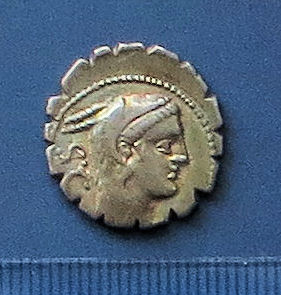The announcement recently of the future issue of a new pound coin because so many of the existing £1 coins in circulation are forgeries reminded me that the ancient Romans had a similar problem. A significant proportion of the silver denarii were silver plated forgeries. The Romans tried to make it harder to forge the denarius by making it with v-shaped cut-outs on the edge of the flan. This was supposed to make it harder to copy as a forgery but in fact within a relatively short space of time the forgers were copying the serratus. It makes you wonder whether the new £1 coin will be any more successful.
The obverse of the serratus shows the head of Juno Sospita wearing a goat’s skin and on the reverse Juno standing in her biga or chariot, with a serpent beneath the horses. The writing says L.PROCILI.F. The Procili family originated in Lanuvium which is where the cult of Juno Sospita was popular. She was supposed to have a protective role in time of war.
I am grateful to Keith Sugden for kindly getting the serratus coin out of the Numismatics collection for me to photograph and share with blog readers.



